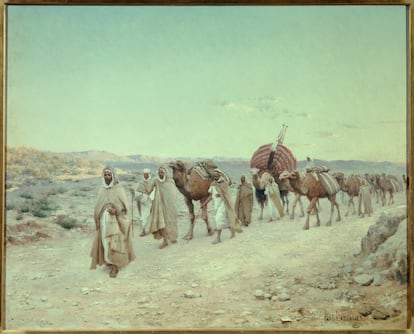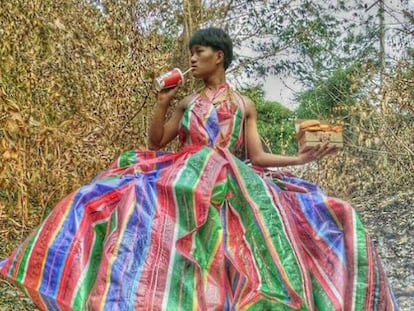The Bedouin lesson: A scientific study proves robes are the best garment to wear in the desert heat
Traditionally worn by Bedouins and Tuaregs, tunics of any color are cooler than any other Western garment

This summer has brought a record-breaking heatwave worldwide. The high temperatures have remained for weeks at a time. Ongoing droughts have exacerbated the issue, as dry soil cannot contribute to temperature regulation through evaporation.
Changes in the flows of atmospheric currents, due to climate change, have sent the air of the African deserts up to the Iberian peninsula, turning half of Europe into an unbearable oven.
And some believe that this will be the coolest summer of our lives. So while governments, companies, NGOs and other social agents agree on how to remedy the effects of climate change, long-suffering citizens have to continue to carry out our usual activities. But how should we dress to maintain our dignity while doing so? Perhaps the key is to turn our attention to other cultures more accustomed to extreme heat.
Since this summer’s exceptional heat comes partly from the African deserts, it seems like a good idea to look at the clothes of the inhabitants of those regions. Most striking about the traditional dress of desert peoples, such as the Bedouins and the Tuaregs, is that their clothes cover them almost completely, even resorting to dark colors. Their wardrobe may be counterintuitive, but it has a solid scientific basis.
As recounted in an article published in Nature, researchers Richard Taylor and Virginia Finch of Harvard University, and Amiram Shkolnik and Arieh Borut of the University of Tel Aviv, set out back in the 1980s to empirically test what type of clothing was best suited to the extreme heat of the desert.
To do this, they asked a volunteer to stand in the sun in the desert around noon wearing four different outfits: a black Bedouin robe, a white Bedouin robe, a brown military uniform, and finally, nothing but shorts. The researchers hypothesized that the Bedouin garments, which have been perfected over the centuries, would be more suitable for the heat, despite how counterintuitive it may seem to Western eyes.
The volunteer carried out four 30-minute sessions, one with each outfit, in the Negev desert, in southern Israel. These were the results.
Uniform or suit
Western formal dress is completely impractical when it comes to dealing with the heat. Our body defends itself from high temperatures through sweat: its evaporation frees us of excess heat. But for this to occur quickly, we need as much air as possible to flow around our body. It goes without saying that a suit or a uniform almost completely prevents that airflow.
If, in addition, the suit or uniform is dark in color, its fabric absorbs the sun’s heat, transmitting it directly to our body: the worst option on a hot day.
Shorts
Wearing very little or nothing at all is a better option. Our skin is in full contact with the outside air, allowing our sweat to evaporate and cooling us down. However, according to what environmental physiology and ergonomics professor George Havenith told NPR, this option also has serious problems.
Apart from the fact that going naked in public spaces is not allowed in many places, we do need to protect our skin from the sun to avoid burning. It is necessary to wear some protective clothing. Sunblock also influences the production of sweat and makes it difficult for it to evaporate. This option, therefore, should be ruled out.
White or black tunic
The results of the study by Taylor, Finch, Shkolnik and Borut were decisive: the wide tunics cooled the air around the volunteer’s body, due to the tunics’ movement with the wind and their wearer’s movement. Its shape also produces a chimney effect, which makes the air rise, circulating between the fabric and the skin. The robes would even be cooler than going naked on a windless day, as they artificially produce airflow.
The authors also concluded that the typical Bedouin costume has the same effects whether it is black or white. The black color does absorb more heat, but it does not reach the skin, so the color of the fabric is not important. The thickness of the fabric of these garments also favors better absorption of temperature, preventing it from reaching the skin.
We may not need to immediately adopt Bedouin garments, but loose outfits will ease us on the hot days ahead of us.
Tu suscripción se está usando en otro dispositivo
¿Quieres añadir otro usuario a tu suscripción?
Si continúas leyendo en este dispositivo, no se podrá leer en el otro.
FlechaTu suscripción se está usando en otro dispositivo y solo puedes acceder a EL PAÍS desde un dispositivo a la vez.
Si quieres compartir tu cuenta, cambia tu suscripción a la modalidad Premium, así podrás añadir otro usuario. Cada uno accederá con su propia cuenta de email, lo que os permitirá personalizar vuestra experiencia en EL PAÍS.
¿Tienes una suscripción de empresa? Accede aquí para contratar más cuentas.
En el caso de no saber quién está usando tu cuenta, te recomendamos cambiar tu contraseña aquí.
Si decides continuar compartiendo tu cuenta, este mensaje se mostrará en tu dispositivo y en el de la otra persona que está usando tu cuenta de forma indefinida, afectando a tu experiencia de lectura. Puedes consultar aquí los términos y condiciones de la suscripción digital.
More information
Últimas noticias
Maduro pleads not guilty before the federal court in New York: ‘I am still the president of Venezuela’
A new test can detect Alzheimer’s from a finger prick
UN team enters Sudanese city of El Fasher after paramilitary massacre: ‘It’s like a ghost town’
A recipe for resistance: Indigenous peoples politicize their struggles from the kitchen
Most viewed
- Gilles Lipovetsky: ‘If you want to live better and fall in love, take Prozac, don’t look to philosophy’
- Alain Aspect, Nobel laureate in physics: ‘Einstein was so smart that he would have had to recognize quantum entanglement’
- Alvin Hellerstein, a 92-year-old judge appointed by Bill Clinton, to preside over Maduro’s trial in New York
- Why oil has been at the center of Venezuela-US conflicts for decades
- Maduro’s downfall puts China’s relationship with Venezuela to the test










































